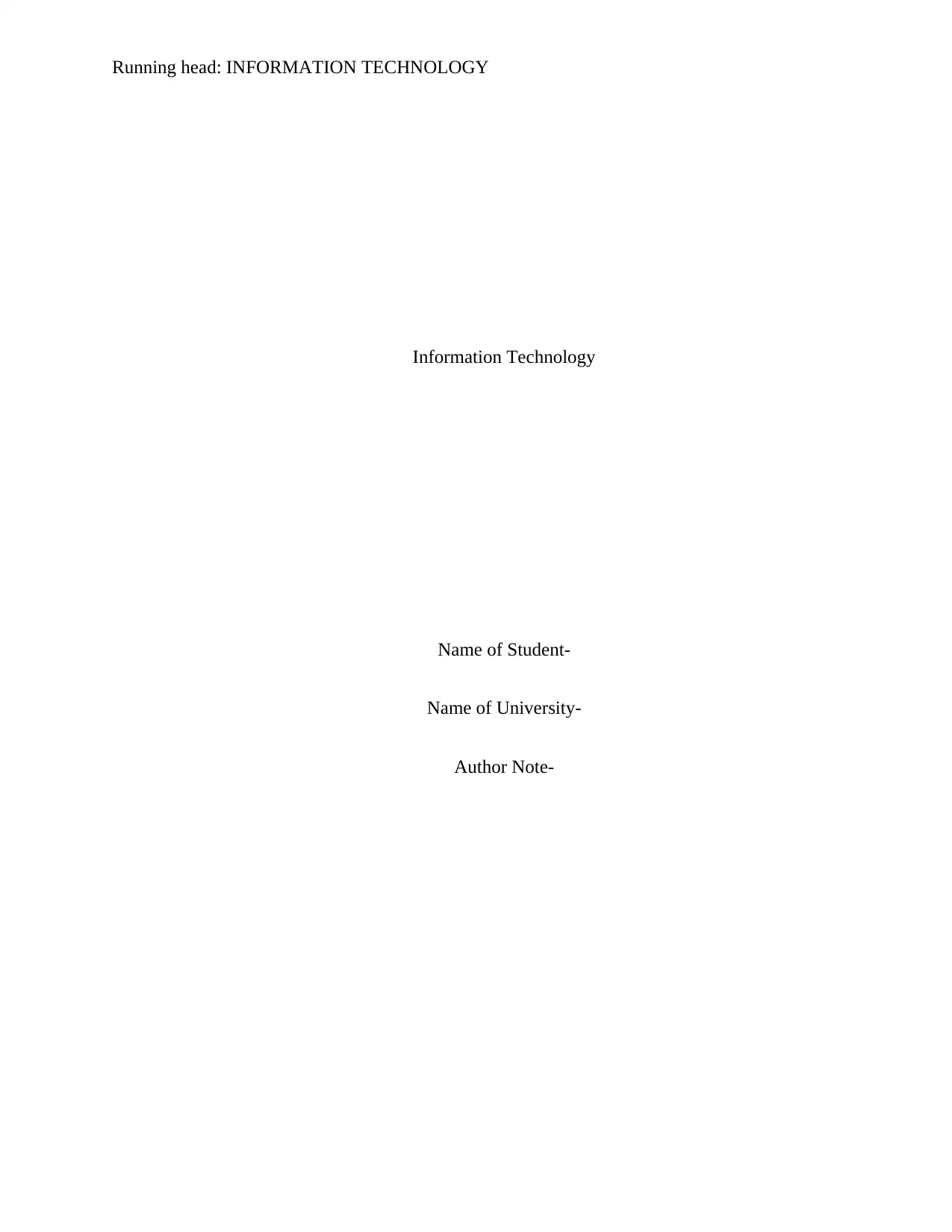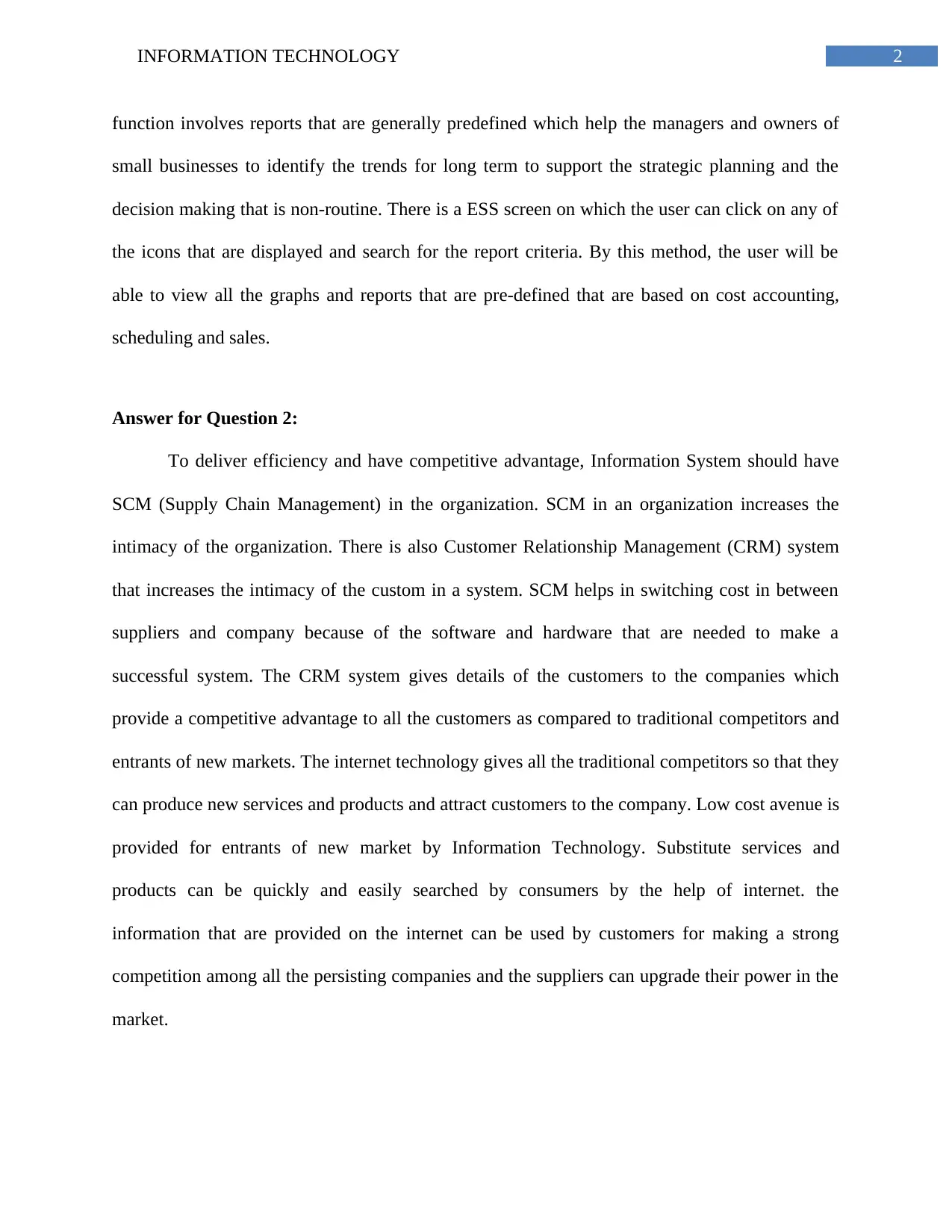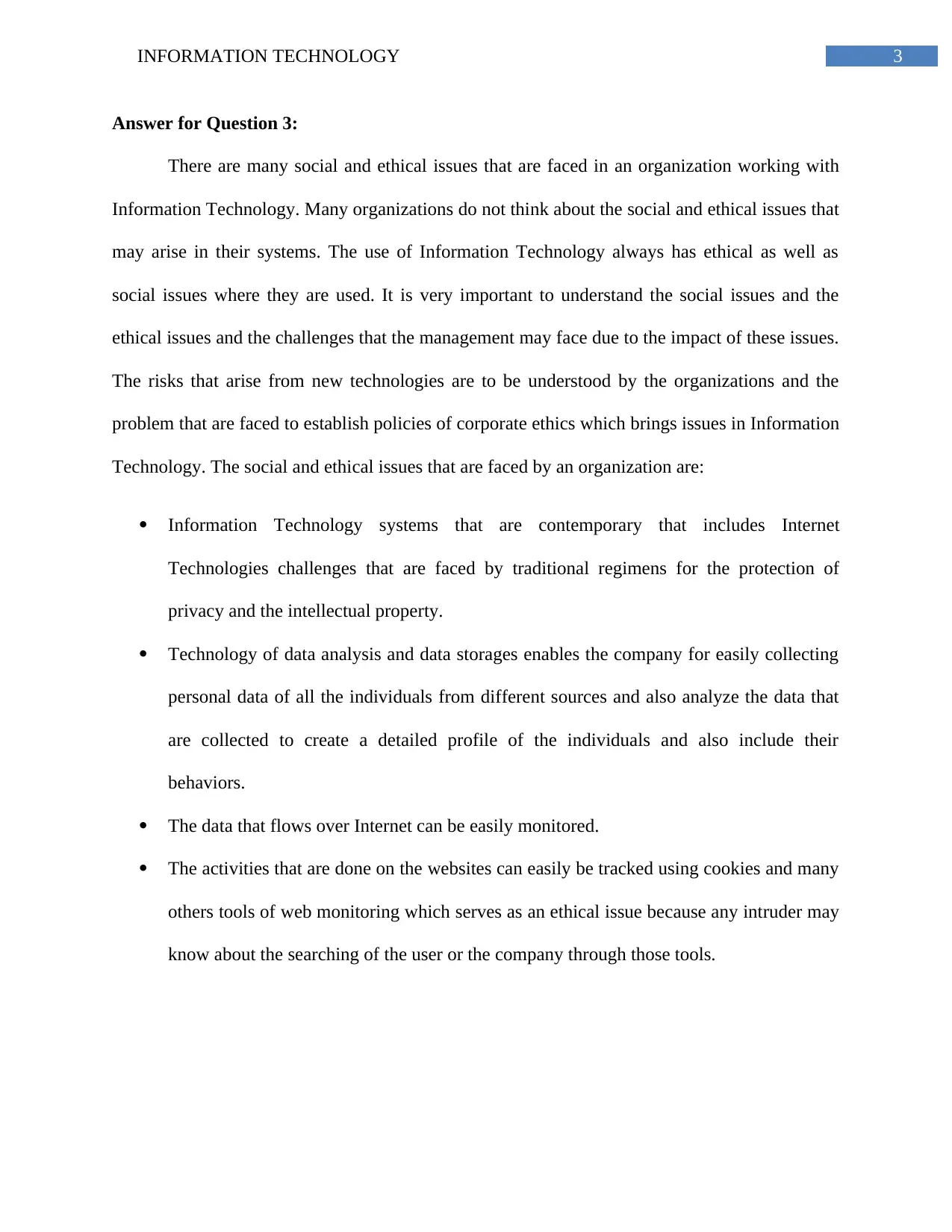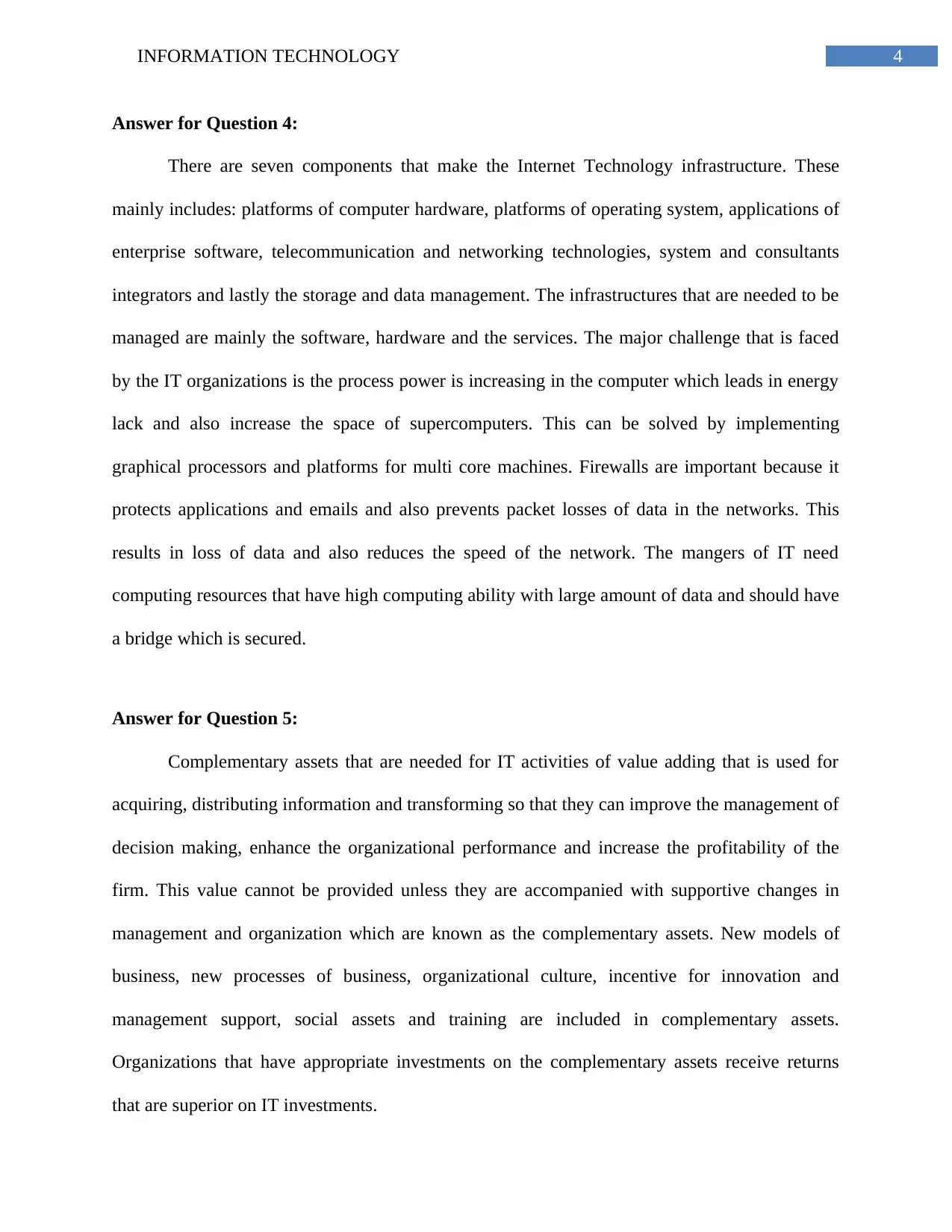Information Technology Assignment - IT Functions & Issues
VerifiedAdded on 2020/04/21
|5
|1197
|84
Homework Assignment
AI Summary
This assignment solution explores various aspects of Information Technology. It begins by outlining the functions of Information Systems, including MIS, TPS, DSS, and ESS, highlighting their roles in business success. The solution then discusses how SCM and CRM systems contribute to efficiency and competitive advantage. Furthermore, the assignment addresses social and ethical issues in IT, emphasizing the importance of understanding and mitigating potential risks associated with data privacy and internet technologies. The solution also identifies the seven components of Internet Technology infrastructure, along with key management challenges and solutions. Finally, it examines the role of complementary assets in maximizing the value derived from IT investments, including business models, processes, and organizational culture. This comprehensive analysis provides a solid understanding of the multifaceted nature of Information Technology.

Running head: INFORMATION TECHNOLOGY
Information Technology
Name of Student-
Name of University-
Author Note-
Information Technology
Name of Student-
Name of University-
Author Note-
Paraphrase This Document
Need a fresh take? Get an instant paraphrase of this document with our AI Paraphraser

1INFORMATION TECHNOLOGY
Answer for Question 1:
There are many functions that the Information System performs to make a business
successful. There are components of Information Technology which includes input things,
processing things, output components and feedback process. The process that is most important
is the feedback process but this is overlooked most of the time. The functions of Information
System mainly include MIS (Management Information System), TPS (Transaction Processing
System), DSS (Decision Support System) and ESS (Executive Support System).
The Management Information System (MIS) is a system that deals with the issues related
to behavior and the issues that are related to technical assets surrounding the organization. MIS
also deals with the impact of system that is used by employees and managers in an industry.
Management Information System deals with the study of information that mainly focuses on the
management and the business of the organization. The second function of Information
Technology is the Transaction Processing System (TPS). The transaction of the business
processes depends on the daily operations that are being carried out in an organization. Daily
transaction includes paychecks creation, purchase orders and many more. All these processes are
done by TPS with IT in an organization.
The third function that is considered is the DSS system. DSS system is known as
Decision Support System. The DSS is helpful for owners and the managers. DSS allows using
ad-hoc reports or predefined reports so that they can support the planning operations and
decisions related with problem resolution. DSS gives answers to particular questions so that they
can evaluate the impact of the decisions that are taken before their implementation. The last
function that is involved in Information Technology is the Executive Support System (ESS). This
Answer for Question 1:
There are many functions that the Information System performs to make a business
successful. There are components of Information Technology which includes input things,
processing things, output components and feedback process. The process that is most important
is the feedback process but this is overlooked most of the time. The functions of Information
System mainly include MIS (Management Information System), TPS (Transaction Processing
System), DSS (Decision Support System) and ESS (Executive Support System).
The Management Information System (MIS) is a system that deals with the issues related
to behavior and the issues that are related to technical assets surrounding the organization. MIS
also deals with the impact of system that is used by employees and managers in an industry.
Management Information System deals with the study of information that mainly focuses on the
management and the business of the organization. The second function of Information
Technology is the Transaction Processing System (TPS). The transaction of the business
processes depends on the daily operations that are being carried out in an organization. Daily
transaction includes paychecks creation, purchase orders and many more. All these processes are
done by TPS with IT in an organization.
The third function that is considered is the DSS system. DSS system is known as
Decision Support System. The DSS is helpful for owners and the managers. DSS allows using
ad-hoc reports or predefined reports so that they can support the planning operations and
decisions related with problem resolution. DSS gives answers to particular questions so that they
can evaluate the impact of the decisions that are taken before their implementation. The last
function that is involved in Information Technology is the Executive Support System (ESS). This

2INFORMATION TECHNOLOGY
function involves reports that are generally predefined which help the managers and owners of
small businesses to identify the trends for long term to support the strategic planning and the
decision making that is non-routine. There is a ESS screen on which the user can click on any of
the icons that are displayed and search for the report criteria. By this method, the user will be
able to view all the graphs and reports that are pre-defined that are based on cost accounting,
scheduling and sales.
Answer for Question 2:
To deliver efficiency and have competitive advantage, Information System should have
SCM (Supply Chain Management) in the organization. SCM in an organization increases the
intimacy of the organization. There is also Customer Relationship Management (CRM) system
that increases the intimacy of the custom in a system. SCM helps in switching cost in between
suppliers and company because of the software and hardware that are needed to make a
successful system. The CRM system gives details of the customers to the companies which
provide a competitive advantage to all the customers as compared to traditional competitors and
entrants of new markets. The internet technology gives all the traditional competitors so that they
can produce new services and products and attract customers to the company. Low cost avenue is
provided for entrants of new market by Information Technology. Substitute services and
products can be quickly and easily searched by consumers by the help of internet. the
information that are provided on the internet can be used by customers for making a strong
competition among all the persisting companies and the suppliers can upgrade their power in the
market.
function involves reports that are generally predefined which help the managers and owners of
small businesses to identify the trends for long term to support the strategic planning and the
decision making that is non-routine. There is a ESS screen on which the user can click on any of
the icons that are displayed and search for the report criteria. By this method, the user will be
able to view all the graphs and reports that are pre-defined that are based on cost accounting,
scheduling and sales.
Answer for Question 2:
To deliver efficiency and have competitive advantage, Information System should have
SCM (Supply Chain Management) in the organization. SCM in an organization increases the
intimacy of the organization. There is also Customer Relationship Management (CRM) system
that increases the intimacy of the custom in a system. SCM helps in switching cost in between
suppliers and company because of the software and hardware that are needed to make a
successful system. The CRM system gives details of the customers to the companies which
provide a competitive advantage to all the customers as compared to traditional competitors and
entrants of new markets. The internet technology gives all the traditional competitors so that they
can produce new services and products and attract customers to the company. Low cost avenue is
provided for entrants of new market by Information Technology. Substitute services and
products can be quickly and easily searched by consumers by the help of internet. the
information that are provided on the internet can be used by customers for making a strong
competition among all the persisting companies and the suppliers can upgrade their power in the
market.
⊘ This is a preview!⊘
Do you want full access?
Subscribe today to unlock all pages.

Trusted by 1+ million students worldwide

3INFORMATION TECHNOLOGY
Answer for Question 3:
There are many social and ethical issues that are faced in an organization working with
Information Technology. Many organizations do not think about the social and ethical issues that
may arise in their systems. The use of Information Technology always has ethical as well as
social issues where they are used. It is very important to understand the social issues and the
ethical issues and the challenges that the management may face due to the impact of these issues.
The risks that arise from new technologies are to be understood by the organizations and the
problem that are faced to establish policies of corporate ethics which brings issues in Information
Technology. The social and ethical issues that are faced by an organization are:
Information Technology systems that are contemporary that includes Internet
Technologies challenges that are faced by traditional regimens for the protection of
privacy and the intellectual property.
Technology of data analysis and data storages enables the company for easily collecting
personal data of all the individuals from different sources and also analyze the data that
are collected to create a detailed profile of the individuals and also include their
behaviors.
The data that flows over Internet can be easily monitored.
The activities that are done on the websites can easily be tracked using cookies and many
others tools of web monitoring which serves as an ethical issue because any intruder may
know about the searching of the user or the company through those tools.
Answer for Question 3:
There are many social and ethical issues that are faced in an organization working with
Information Technology. Many organizations do not think about the social and ethical issues that
may arise in their systems. The use of Information Technology always has ethical as well as
social issues where they are used. It is very important to understand the social issues and the
ethical issues and the challenges that the management may face due to the impact of these issues.
The risks that arise from new technologies are to be understood by the organizations and the
problem that are faced to establish policies of corporate ethics which brings issues in Information
Technology. The social and ethical issues that are faced by an organization are:
Information Technology systems that are contemporary that includes Internet
Technologies challenges that are faced by traditional regimens for the protection of
privacy and the intellectual property.
Technology of data analysis and data storages enables the company for easily collecting
personal data of all the individuals from different sources and also analyze the data that
are collected to create a detailed profile of the individuals and also include their
behaviors.
The data that flows over Internet can be easily monitored.
The activities that are done on the websites can easily be tracked using cookies and many
others tools of web monitoring which serves as an ethical issue because any intruder may
know about the searching of the user or the company through those tools.
Paraphrase This Document
Need a fresh take? Get an instant paraphrase of this document with our AI Paraphraser

4INFORMATION TECHNOLOGY
Answer for Question 4:
There are seven components that make the Internet Technology infrastructure. These
mainly includes: platforms of computer hardware, platforms of operating system, applications of
enterprise software, telecommunication and networking technologies, system and consultants
integrators and lastly the storage and data management. The infrastructures that are needed to be
managed are mainly the software, hardware and the services. The major challenge that is faced
by the IT organizations is the process power is increasing in the computer which leads in energy
lack and also increase the space of supercomputers. This can be solved by implementing
graphical processors and platforms for multi core machines. Firewalls are important because it
protects applications and emails and also prevents packet losses of data in the networks. This
results in loss of data and also reduces the speed of the network. The mangers of IT need
computing resources that have high computing ability with large amount of data and should have
a bridge which is secured.
Answer for Question 5:
Complementary assets that are needed for IT activities of value adding that is used for
acquiring, distributing information and transforming so that they can improve the management of
decision making, enhance the organizational performance and increase the profitability of the
firm. This value cannot be provided unless they are accompanied with supportive changes in
management and organization which are known as the complementary assets. New models of
business, new processes of business, organizational culture, incentive for innovation and
management support, social assets and training are included in complementary assets.
Organizations that have appropriate investments on the complementary assets receive returns
that are superior on IT investments.
Answer for Question 4:
There are seven components that make the Internet Technology infrastructure. These
mainly includes: platforms of computer hardware, platforms of operating system, applications of
enterprise software, telecommunication and networking technologies, system and consultants
integrators and lastly the storage and data management. The infrastructures that are needed to be
managed are mainly the software, hardware and the services. The major challenge that is faced
by the IT organizations is the process power is increasing in the computer which leads in energy
lack and also increase the space of supercomputers. This can be solved by implementing
graphical processors and platforms for multi core machines. Firewalls are important because it
protects applications and emails and also prevents packet losses of data in the networks. This
results in loss of data and also reduces the speed of the network. The mangers of IT need
computing resources that have high computing ability with large amount of data and should have
a bridge which is secured.
Answer for Question 5:
Complementary assets that are needed for IT activities of value adding that is used for
acquiring, distributing information and transforming so that they can improve the management of
decision making, enhance the organizational performance and increase the profitability of the
firm. This value cannot be provided unless they are accompanied with supportive changes in
management and organization which are known as the complementary assets. New models of
business, new processes of business, organizational culture, incentive for innovation and
management support, social assets and training are included in complementary assets.
Organizations that have appropriate investments on the complementary assets receive returns
that are superior on IT investments.
1 out of 5
Related Documents
Your All-in-One AI-Powered Toolkit for Academic Success.
+13062052269
info@desklib.com
Available 24*7 on WhatsApp / Email
![[object Object]](/_next/static/media/star-bottom.7253800d.svg)
Unlock your academic potential
Copyright © 2020–2025 A2Z Services. All Rights Reserved. Developed and managed by ZUCOL.



